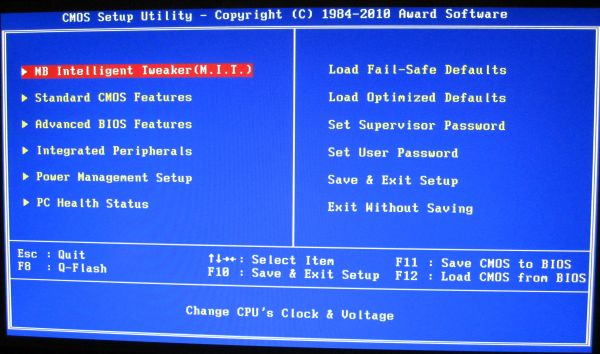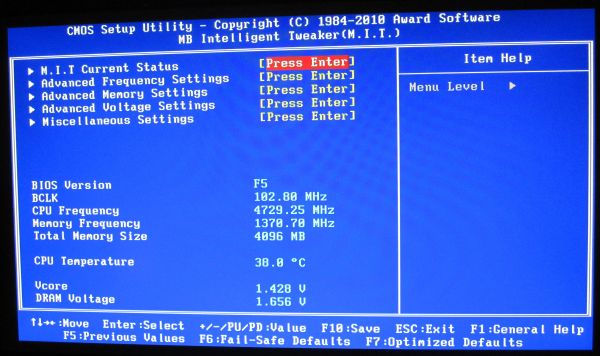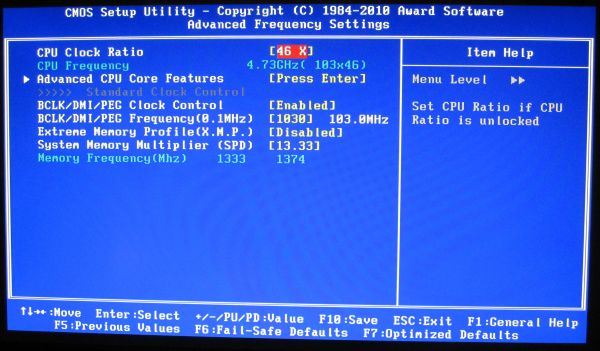The Battle of the P67 Boards - ASUS vs. Gigabyte at $190
by Ian Cutress on January 20, 2011 4:15 PM EST- Posted in
- Motherboards
- Gigabyte
- Asus
- P67
BIOS
Gigabyte has not been on the ball BIOS/UEFI wise for Sandy Bridge. In the Visual Inspection, I explained at how the board is actually 64-bit UEFI but with a BIOS interface attached (for stability, after years of working at it) with plans to possibly upgrade to a GUI at a later date. Though in the name of stability, the launch BIOS has significant issues with turbo boosting, where only a 1x multiplier boost gets applied at any thread loading, rather than 4x/3x/2x. It wasn't as simple as downloading the latest BIOS from the website and updating - in order to get it to work properly, I had to load in an OS, and download the latest version of @BIOS, their BIOS updating tool, and grab the latest BIOS. You cannot use the version of @BIOS on the CD, you need the latest version, and you cannot use QFlash in the BIOS, as they both do not recognise any BIOS F6 or above as valid. I downloaded the latest BIOS file from the website, and use @BIOS to update from the file. At the time of writing, the F7b BIOS is the latest, which implements turbo modes correctly.
If you have worked with a BIOS before, Gigabyte is not throwing up too many new features to surprise you – only those based around Sandy Bridge. Everything overclocking, CPU and voltage related is found in the Intelligent Tweaker menu, whereas boot order can be found in the advanced BIOS options.
The Intelligent Tweaker menu gives a quick overview of BCLK, frequency, temperature, voltages, etc. By dividing the all the OC options into the ‘frequency’, ‘memory’, and ‘voltage’ sub-menus, while this splits up the options to make them easier to digest, it does result in more navigation. Personally, I would prefer being able to adjust the CPU/DRAM voltages in the frequency settings as well as the voltage settings.
Thankfully, most of the settings can be adjusted by typing in a value, or by the +/- buttons, or by pressing enter to type/bring a scrollable menu up. I like being able to do this in a BIOS/UEFI, and most manufacturers will leave out at least one of the available ways to change a setting in every sub-menu, or mix and match as they deem appropriate.
The BIOS allows eight profiles to be saved on board, or you can save/load to a file. Given some of the overclocking problems I mention below, every time a re-flash of the BIOS was required, all my saved on board settings were lost.
Overclocking
Overclocking on the P67-UD4 was almost as easy as it has been on previous BIOS boards, although there was no easy overclock presets available in the BIOS. EasyTune6, the OS software on the Gigabyte CD, gives automatic options for 35x, 37x and 40x multiplier at 100 MHz bus speed. These settings, as in previous Gigabyte iterations and boards, work pretty well, but a 4 GHz overclock on Sandy Bridge is not going to win any awards.
Going into the BIOS, I immediately left everything on auto and upped the multiplier to 45x, for a 4.5 GHz processor speed. This successfully booted into Windows, passed the stability tests, then BSOD on shutdown. On the restart, the board attempted to boot back at stock, which was disappointing.
As with previous overclocking attempts, I jumped in and put the VCore straight at 1.42V, with a 1.9V PLL. Upping the multiplier to 45x to give 4.5 GHz this time was no trouble. 4.6 GHz and 4.7 GHz also passed without issue. 4.8 GHz booted into the OS, but failed the OCCT stress test, so I rolled back the multiplier to 47x and started playing with the BCLK by 1 MHz at a time. 101 MHz also failed the stress test, leaving 47 * 100 MHz as a good overclock. This board automatically puts a -0.2 MHz bias on the BCLK, meaning that the speed is actually 47 * 99.8 MHz = 4.69 GHz.
Out of interest, I rolled back the multiplier again to 46x and upped the BCLK this way. With a 102.2 MHz BCLK, it would beat the speed of the 47 * 100 MHz overclock, so I booted at 102.5 MHz (102.3 MHz effective), with a 46x multiplier, which passed. 103 MHz did not however, so 102.5 MHz * 46 (102.3 MHz * 46 effective = 4706 MHz) would seem the best option, as it contains that small little BCLK boost to help other components and memory.
With the board’s Dual BIOS system, on a severe failed boot type unsuccessful overclock by increasing the multiplier too much, the board would revert to the backup BIOS, and then boot me straight into the BIOS. If I changed anything, it would load the standard BIOS again with my new settings. Also of note, if I upped the BCLK too far, the system would restart in one of two ways – without any overclock at all, or at 100 MHz with my chosen multiplier. If I increased the RAM too far, it would keep rebooting and never getting to the POST screen until I used a jumper on the Clear CMOS header. Note, no jumpers are included in the box, so you have to find your own way of shorting those pins. I also tried going for 50x multiplier, 100 MHz BCLK, at 1.50 V. On a failed boot into Windows, the main BIOS became corrupted and had to be restored by the backup – then I had to load into the OS to run @BIOS to update to the F7b BIOS again, because the backup BIOS is F1 and doesn’t recognise the F7b BIOS file as a valid BIOS, which was frustrating.
At 4.706 GHz (42.6% OC over 3.3 GHz/non turbo/multithreaded, 27% OC over 3.7 GHz/turbo/single-threaded), the 3D Movement benchmark was run. In single thread mode, a score of 145.19 was achieved, a 28% increase. In multi-threaded mode, a score of 463.12 was achieved, a 38.6% increase.



















137 Comments
View All Comments
Hogan773 - Friday, January 21, 2011 - link
No - its 42 dollars more for the Extreme 6 vs Extreme 4.If it were 10 bucks like you said, I'd get the 6. But not for 40 bucks.
cjs150 - Friday, January 21, 2011 - link
to full fat ATX boards anymore?With all the features being crammed in surely 99% of all users were find their needs met with a decent micro-atx board - heck probably 60%+ would be fine with a mini-ITX board.
Seriously do we really need 3 graphics card slots, 2 way SLI/Crossfire is overkill for the vast majority of people.
As on board sound gets better and better most people have given up on a sound card.
The most slots I have populated over the last 5 years is 5 (2 graphics cards, sound card, TV tuner and RAID card) and that was truly the exception. These days all I need is 3 cards for 2 way SLI and a TV tuner
strikeback03 - Friday, January 21, 2011 - link
Would also help if PCI disappeared so there was no question over what slots were included/available with certain cards. For example, the uATX board in my HTPC has 1 PCIe X1, 1 PCIe X16, and 2 PCI, which meant I had to get a PCI wireless card and if I wanted to add any additional tuners would have to get PCI for that as well, would have preferred more/all PCIe.Also, the spot in my desk for a tower isn't getting any smaller, no reason to not use a full-size ATX board with that much space.
7Enigma - Tuesday, January 25, 2011 - link
Yup. I have the space for a mid/full tower below my desk. It does no good for me to have a m-atx (actually it'd make it worse since it would be lower for the optical drive!). I also hate playing the cram game when trying to build and work on systems that are in such tight confines.Sure for people with very limited space or HT setups it's nice to have a smaller form factor, but a LOT (the majority?) of desktop users have a similar setup where space is rarely a real issue and the extra real-estate for cable management, component selection/replacement, and airflow/noise is a much greater factor.
seamusmc - Friday, January 21, 2011 - link
Gigabyte's and ASUS' offerings at the $150 price point. The main difference between ASUS' Pro and Non-Pro are SLI support and the Intel Nic.Personally I'd love to see a review of cheaper boards. Would it significantly reduce price if they didn't include on-board audio?
The main reason I'm considering the Pro is the Intel Nic, though I'm not sure if its really a big deal.
Another reason I am considering ASUS is that Gary Key and his staff are on the Xtreme and HardOCP forums addressing issues folks are encountering, providing OC guides and updated BIOS not available from the official site.
Not saying that there are no issues with the ASUS line, there are, but it seems many problems with the ASUS line are corrected by a) Using 1.5v memory; b) Fresh install of Win7; c) Over-clocking correctly, some folks are trying things that don't apply to SandyBridge.
Arbie - Friday, January 21, 2011 - link
We are six pages into the discussion with no signs of an idiotic flame war! This must be a recent record for Anandtech. Whatever the reason, it's certainly refreshing.7Enigma - Tuesday, January 25, 2011 - link
Trolls are still sleeping. And since it's not the normal FW companies (Intel vs. AMD, Nvidia vs. ATI).jfelano - Friday, January 21, 2011 - link
I don't understand the point of testing just TWO boards at a $190 price point. Makes no sense.DanNeely - Friday, January 21, 2011 - link
Maybe only Asus and Gigabyte gave $190 boards to review...LoneWolf15 - Friday, January 21, 2011 - link
While this may not be worth it to many, note that the ASUS board has an Intel gig NIC, and the Asrock has a Realtek.This also means (for what it's worth) that the ASUS board supports Intel VPro, while the Asrock does not. For many people, that isn't a factor --but it is worth knowing.
Just looked at that Asrock board --I think it's the first I've seen by them that I found really impressive on paper. I might have to read some reviews on it.